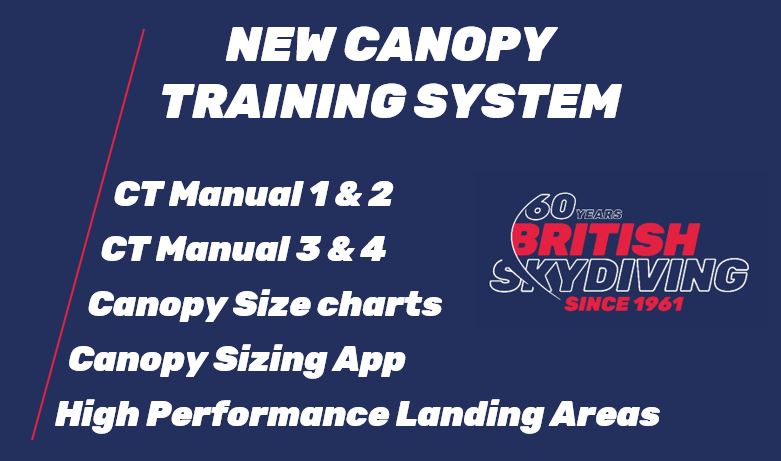In 2020, we have seen a reduction in the number of descents carried out, mostly due to the COVID-19 Pandemic, however, during the first quarter of 2020, we were also affected by some of the worst winter months we had experienced for several years. For some members, it may have been close to 9 months by the time they returned to the skies, for others it may have been longer, and for the rest, you may have not set foot on a Drop Zone to this date.
As we begin to see what appears to be an end to the Pandemic, we are now a step closer to returning to skydiving after another period of lockdown which has kept us all away from our home Drop Zones. For those who choose to return to the skies, most of us will be very uncurrent, so we need to consider the safety implications of a prolonged period without carrying out a skydive.
I am sure that our Chief Instructors will consider implementing some currency requirements before allowing you to skydive once again, and they are best placed to know whether you have the experience, the ability, or competence to carry out your chosen discipline. Be sensible about wanting to rush back into the plane, slow everything down, make sure you get your briefs, you get your checks, you familiarise yourself with any new procedures and the reason for having them. If there is anything you are unsure of, you just need to ask a member of staff or an instructor.
Remember, if you are uncurrent, you may also want to consider what the weather conditions may be like on the day, as they may not always be suitable for your level of experience. I would rather wait and skydive on another day, than risk putting myself in a situation that may lead to harm, especially after a long break. Remember to ask if you are unsure.
Once you are back in the aircraft, it is probable that you would still be able to get out of the aircraft safely, fall stable and deploy your canopy with relative ease. The skill required in some of the more technical manoeuvres in any chosen discipline can fade if it has not been practiced for a prolonged period without continuous practice.
Our more experienced members may show less skill fade than those with less experience, however, their ability can be affected just the same. Continuous practice and good motor skills help us all improve our performance; however, we must be mindful of skill fade and the inability to perform or maintain the same standard we had before we took a break. To those keen canopy pilots, please come back slowly.
Instructors and coaches should be mindful that the flying skill required to fly competently in any instructional or coaching discipline can also fade if not practiced, so getting back in the air before delivering instructional duties should help regain confidence and ability.
Human error
The safety and Technical Committee of the International Skydiving Commission (ISC), have written to all National Governing Bodies and highlighted two main areas for concern which are contributing factors to recent skydiving fatalities worldwide;
- Intentional Fast Landings/Other Landing Errors
- Cutaway No Reserve/Cutaway Low Reserve/Too Low Deployment
The ISC has looked at data over five years and concluded, that on average, HUMAN ERROR accounted for 74% – three out of four – skydiving fatalities. While HUMAN ERROR is a factor in all areas of human activity, such as road traffic accidents, work accidents, and sport, so it is of the greatest importance that we do everything possible to lessen the impact of HUMAN ERROR in skydiving.
I believe that with the introduction of our new Canopy Training System, we are addressing some of the issues mentioned by ISC, which British Skydiving identified way back in 2005 when the new Canopy Handling (CH) and Canopy Piloting (CP) manuals were produced, and further training requirements were introduced into our Grading System. Fifteen years on, there has now been a complete rewrite of the Manuals, with enhanced content based on new, more evolved teaching techniques and providing better information for the skydiver.
The new Canopy Training Manual which covers, Canopy Training (CT) for students, and the new Grading System CT1 & CT2 and the New Canopy Training Manual for CT3 & CT4 also part of the grading system, are now available on the website. Instructors and Coaches should familiarise themselves with the latest amendments to the Operations Manual published on 01 April. Changes have been made to Sections 2, 6, 7 & 10.
We have introduced a canopy size chart, (Forms 330i – 330ii, – 330iii) to ensure that all skydivers who have not yet completed 2000 descents, use a canopy that is of a suitable size for their experience and training, as evidence has identified that over time, skydivers are doing fewer or not enough jumps on their canopies, before moving on to a more modern, smaller, and faster canopy with a higher wing loading. If you are unsure of the new system and you want to know more, speak to your CI, who will be able to provide the information you need.
A complementary mobile app for the new Canopy Training system has been produced to simplify working out minimum canopy sizes by experience.
The app is available for Android from Google Play and for iOS from the App Store.
Simply enter your licence, exit weight (kg) and number of jumps and it will tell you the minimum canopy size you are permitted to jump. Swiping left will display a graph showing the downsizing progression for the current experience. Information icons can be tapped for further details.
The User Interface may need tweaking depending on the device screen size and the orientation. Get in contact if you have any experience and would like to assist in tidying it up, or if you have any other feedback craig@britishskydiving.org
You can find a good explanation of the New Canopy Training system from one of our Chief Instructors here.
High-performance landings with a final turn over 90 degrees are required to be carried out onto designated High-Performance Landing Areas (HPLAs). Guidelines for High-Performance Landing areas can be found on Form 331 and their requirements in Section 7 of the Operations Manual.
British Skydiving has a duty of care to its members, to ensure that we can all continue to enjoy skydiving, by giving us the necessary tools to progress, but also by controlling our exposure to risk. It is impossible to completely remove the risk out of skydiving, but what is important, is that we manage the risk, so that it allows us to achieve the best level of safety within an already safe system, your system, British Skydiving’s system.
Having a system that controls the speed at which a skydiver moves on to a smaller faster canopy, and that provides the necessary training to go with it, can only help increase our awareness by the time we have sufficient experience to move to a smaller canopy. This should help reduce or prevent the number of landing accidents and fatalities.
It is also very important that we refresh ourselves on emergency procedures, practice our reserve drills and revise ourselves on actions to take in the event of an aircraft emergency. The New Canopy Training Manual for CT, CT1 & CT2, has very good information which can teach or revise current members on what to do in the event of a canopy collision (see page 48). It covers several scenarios which can be of use when revising entanglement and cutaway procedures. Your CI is the best person to clarify any questions you may have on any of the content.
You may also want to think about the serviceability and condition of your parachute system and any equipment ancillaries. Some equipment considerations can be:
- Check your Batteries: Altimeters & Audibles.
- Check your Rig – Is everything in order and serviceable.
- Do you need a reserve repack? Riggers & packers will be getting busy.
- Check your record of inspection. Is your AAD in date, does it need a service?
Check with your PTO to see if they are delivering any Safety Days and familiarize yourself with the Return to Skydiving COVID-19 Guidelines and any changes to the PTO Standard Operating Procedures (SOPs).
On behalf of myself and the Association, we hope you return to the skies safely, whenever you choose to do so.
Jeff Montgomery
British Skydiving Safety & Technical Officer.


